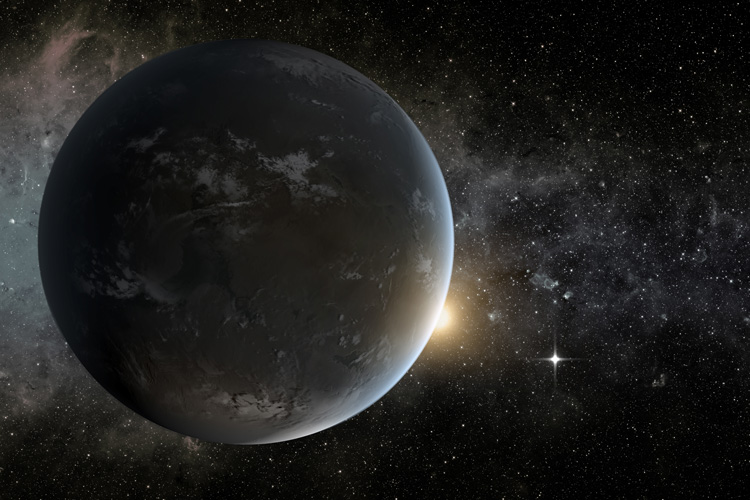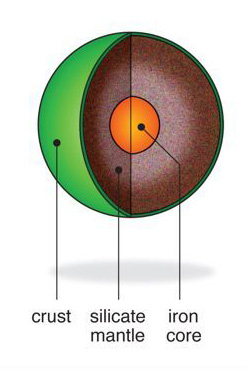What magnetic fields can tell us about life on other planets

Every school kid knows that Earth has a magnetic field – it’s what makes compasses align north-south and lets us navigate the oceans. It also protects the atmosphere, and thus life, from the sun’s powerful wind.
But what about other Earth-like planets in the galaxy? Do they also have magnetic fields to protect emerging life?
A new analysis looks at one type of exoplanet – super-Earths up to five times the size of our own planet – and concludes that they probably do have a magnetic field, but one generated in a totally novel way: by the planets’ magma oceans.
The surprising discovery that slowly churning melted rock at or under the surface can generate a strong magnetic field also suggests that in Earth’s early years, when it was largely a lump of melted rock, it also had a magma-generated magnetic field. This was in addition to its present-day field, which is generated in the liquid-iron outer core.
“This is a new regime for the generation of planetary magnetic fields,” said Burkhard Militzer, a UC Berkeley professor of earth and planetary science. “Our magnetic field on Earth is generated in the liquid outer iron core. On Jupiter, it arises from the convection of liquid metallic hydrogen. On Uranus and Neptune, it is assumed to be generated in the ice layers. Now we have added molten rocks to this diverse list of field-generating materials.”
The link between a planet’s interior and its magnetic field also provides a way for astronomers to learn about the makeup and ages of exoplanets too far away to visit.
“This is far in the future, but if someone makes an observation of an exoplanet and they find a magnetic field, that may be an indication that there is a magma ocean, even if they cannot see this directly,” Militzer said.
The conclusions also have implications for chances for life on other planets. As magma oceans cool from the top, a surface hospitable to life could appear while the melted mantle continues to churn.
“A magnetic field is helpful in protecting a planetary atmosphere from being blown away by the stellar winds,” said former UC Berkeley postdoctoral fellow François Soubiran, now at the École Normale Supérieure in Lyon, France. “Most of the super-Earths we are detecting now are very close to their host stars and exposed to very strong stellar winds. Thus, the possibility for a magnetic field to exist is definitely a key component in the evolution of the planet and its habitability.”
Soubiran and Militzer published their findings Sept. 24 in the journal Nature Communications.
Earth’s internal dynamo
The magnetic field of Earth today is generated in the molten-iron outer core, where rising and sinking masses of electrically conducting liquid iron, combined with the planet’s spin, create a dynamo and a persistent magnetic field.

But the rocky Earth was molten after its initial formation 4.5 billion years ago, and some layers may have remained molten and convecting – like boiling water, only slower – for millions of years after its birth. Could the slowly convecting magma ocean have generated a magnetic field akin to the one generated in the iron core today?
The same question arose after super-Earths were discovered around other stars. Super-Earths are so massive that their interior, the mantle, should remain liquid and convecting for a few billion years after formation.
In both cases, the slowly boiling magma on a spinning planet can generate a strong magnetic field only if the liquid rock conducts electricity.
No one knew if this was true.
Experiments on silicates – a term referring to the thousands of silicon-based minerals that make up Earth’s rocky interior – at the high temperatures and pressures inside a super-Earth are difficult. Even establishing whether a rock remains solid or becomes liquid is not straightforward at the conditions typical of planetary interiors: temperatures of 10,000 Celsius and pressures 10 million times that of the air around us.
“At standard temperatures and pressures, silicates are completely insulating; the electrons are either tightly bound to the nuclei or they are in molecular bonds and not able to freely move and create macroscopic electric currents,” Soubiran said. “Even if the high internal pressure helps reduce the barriers for the electrons to move, it was not necessarily obvious silicates would be conducting in super-Earths.”
But Soubiran and Militzer had access to atomic-scale computer models of minerals that allowed them to calculate the conductivity of, in this case, quartz (silicon dioxide), magnesia (magnesium oxide) and a silicon-magnesium-oxide (post-perovskite), all of which are common in rocks on Earth, the moon and probably all of our solar system’s planets.
After performing lengthy calculations for each of the three, they discovered that these silicates become modestly conducting when they change from solid to liquid at high temperatures and pressures. When they plugged the conductivities into models of Earth’s interior, they discovered that the rocks were sufficiently conducting to sustain a dynamo and thus a magnetic field.
“Our calculations showed that the disorganized structure of the liquid helped the electrons become conducting,” Soubiran said. Liquid silicates at 10,000 Celsius and 10 million atmospheres of pressure have only about one-hundredth the conductivity of liquid iron, for example.
Soubiran noted that planets rotating with a period of two days or more would generate an Earth-like magnetic field: a dipole field with a clear north and south. Slower rotation, however, could create a more disorganized field that would be harder to detect from afar.
Bruce Buffett, a UC Berkeley expert on the dynamics of Earth’s interior who was not involved in the research, said that planets can generate magnetic fields only if they have the right balance of electrical conductivity and fluid velocity to create the feedback necessary to sustain a magnetic field.
“The expectation of many geophysicists was that, at least under Earth conditions, the conductivity of liquid silicates would fall more into the category of, well, if you had really, really large fluid motions to compensate for a low conductivity, you might have a magnetic field,” said Buffett, a professor of earth and planetary science. “This is the first detailed calculation for higher temperature and pressure conditions, and it finds that the conductivities appear to be a little bit higher, so the fluid motions you would need to make this all work are maybe a little bit less extreme.”
The work was supported by the National Science Foundation.
RELATED INFORMATION
